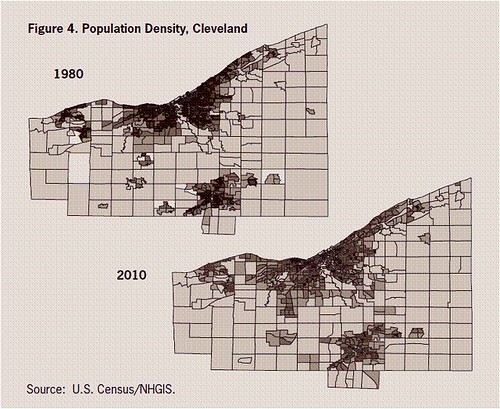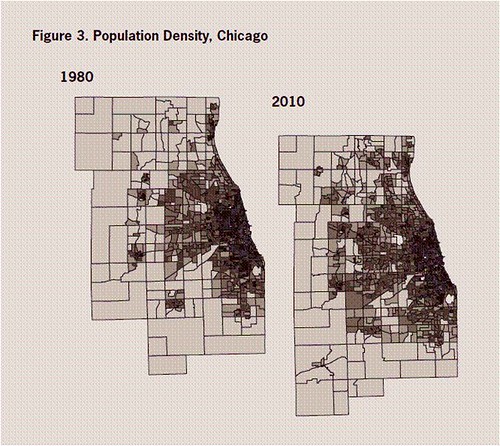Rust Belt cities: to avoid more shrinkage, protect & strengthen the core

Posted January 4, 2012 at 1:26PM
For some time, I have been on record as believing that the problem with former industrial cities that have lost population isn’t just the changing economy. It’s also a failure to address suburban sprawl. A close look at population data reveals that, while the populations within central cities’ jurisdictional boundaries have declined substantially, their suburbs have actually grown. The result is that, if one defines “city” as the contiguous urbanized area within a metro region, regardless of political boundaries – the definition that matters to the economy and the environment – the shrinkage may vanish or be shown as far less than we think.
In short, “shrinking cities” have really been hollowing out more than shrinking. Any policy tools that fail to recognize this have little chance of improving the situation, in my opinion.
A new study from the Federal Reserve Bank of Cleveland lends weight to the argument that a dense urban core is important to the overall strength of a metro region. The researchers examined population changes in census tracts within 180 metro areas, noting the location of tracts that gained or lost population – and by how much – in the 1980s, 1990s, and from 2000-2010.  They found that, where regions grew, tracts near the center held relatively steady compared to those in the suburbs. But, in those regions that shrank overall, a disproportionately greater share of the losses took place in the centers.
They found that, where regions grew, tracts near the center held relatively steady compared to those in the suburbs. But, in those regions that shrank overall, a disproportionately greater share of the losses took place in the centers.
Indeed, in metro areas that grew in population (e.g., Sun Belt regions and stronger older regions such as Boston, Chicago, and Philadelphia), the greatest growth from 2000 to 2010 took place not just near the center but in downtown census tracts. The comeback of America’s downtowns and adjoining older neighborhoods is real. But, in those metros that lost population (e.g., Detroit, Cleveland, Buffalo), losses remained greatest near the cores. A sign of encouragement for the shrinking regions, however, may be that their downtowns lost significantly less population after 2000 than did census tracts between three and fifteen miles from the central business district.
The authors summarize:
“Overall, in growing cities, population density either remained the same or increased in most areas. In contrast, in shrinking cities, formerly high-density city centers saw the biggest drop in density, while the surrounding low-density areas saw an increase population density. In practice, this thinning out of high-density areas of shrinking cities is consistent with population movements out of urban areas and into the surrounding suburbs.”
The study includes density maps showing how Atlanta and Chicago maintained their core densities between 1980 and 2010, while Detroit and Cleveland lost theirs.  All four regions show suburban and exurban growth, though to a lesser degree in the shrinking regions compared with the growing ones. (Atlanta’s map shows sprawl that is, not to put too fine a point on it, just off-the-charts ridiculous.)
All four regions show suburban and exurban growth, though to a lesser degree in the shrinking regions compared with the growing ones. (Atlanta’s map shows sprawl that is, not to put too fine a point on it, just off-the-charts ridiculous.)
So: regardless of what’s happening in the suburbs, holding on to a city’s core population appears important to overall regional success. Unfortunately, finding policy mechanisms to promote that outcome in the US, with our highly decentralized and fragmented patterns of municipal governance, remains a formidable challenge and well beyond the scope of a brief blog post. (There’s reason for hope in a few places, such as California.) But, even in the US, we have some regional and state mechanisms, from metropolitan planning organizations that allocate transportation spending to commissions that regulate utilities. If properly aligned, those could begin to make a difference.
But perhaps the strongest potential force for bringing sense to our settlement patterns and strengthening central cities may be the business community. This study cites evidence, for example, demonstrating that density is important to productivity (see related academic papers here, here and here). The new findings add to its credibility. Some employers are already reinvesting in core areas (even Detroit) in lieu of further sprawl. I have a feeling that, if business becomes further convinced that reversing the decline of our older cities and neighborhoods is in its interest, the political tools may begin to fall into place.
Move your cursor over the images for credit information.
Please also visit NRDC’s sustainable communities video channel.
